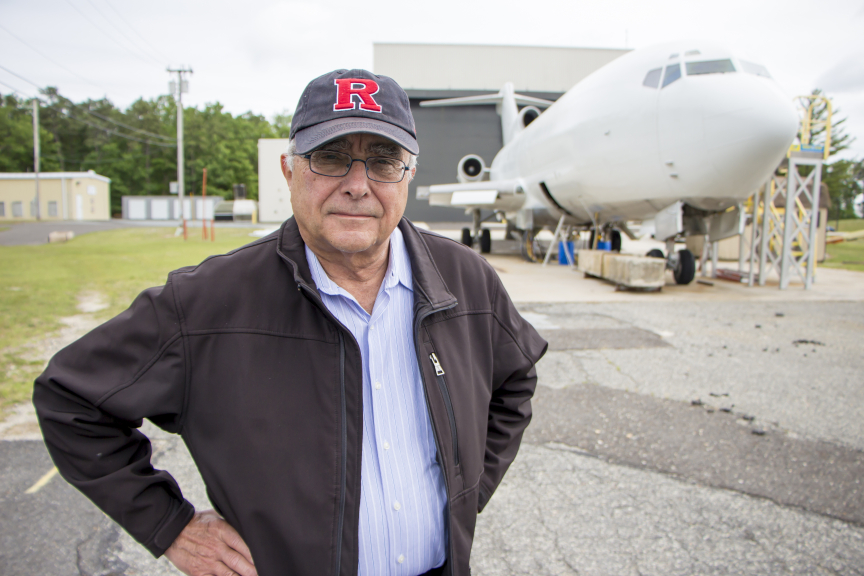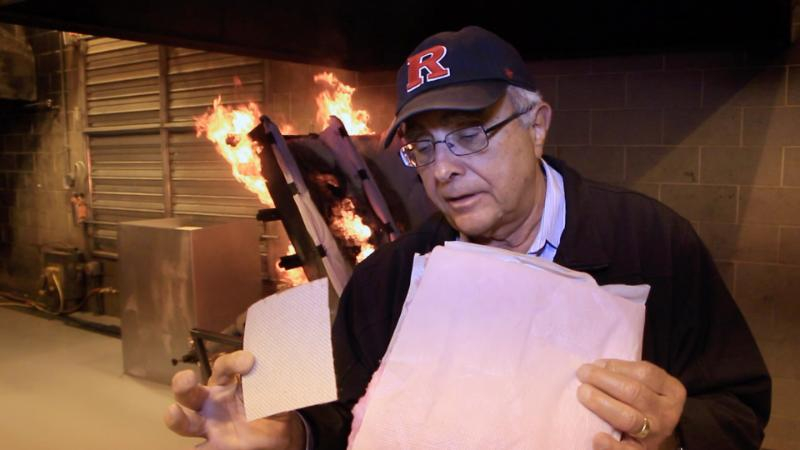Constantine Sarkos: Leading the FAA’s Effort to Reduce Airliner Fire Hazards
Two-time Rutgers alumnus devotes career to developing major fire-safety improvements, giving passengers precious extra time to escape plane crashes

'The probability of dying from fire in a survivable accident when I started 46 years ago was 12 percent and now it’s about 4 percent – and because of the fire safety improvements we have made, the chances of an accident caused by an in-flight fire or fuel tank explosion has been reduced significantly.'– Constantine Sarkos

Air travelers around the world are alive today because of the fire-safety innovations of Rutgers alumnus Constantine Sarkos.
People like the 100 passengers and five crew members who had time to escape when a Continental 737 veered off the runway in Denver into a ravine and erupted into flames in 2008.
Or the passengers traveling in 2013 from Seoul, South Korea, on Asiana Airlines Flight 214, which crash-landed at San Francisco, smashed into pieces and caught fire. Three people died from injuries unrelated to the fire, while 304 survived.
Sarkos, manager of the Federal Aviation Administration’s Fire Safety Branch, heads up a research and development team of engineers, chemists, technical experts and computer scientists at the William J. Hughes Technical Center, 10 miles west of Atlantic City in Egg Harbor Township – the most extensive aviation fire safety research facility in the world.
“Gus does the science that becomes the fire-safety standards adopted by the whole world,” says Dennis Filler, director of the FAA's Hughes Technical Center. “His efforts have provided added time for passengers to evacuate. In the old days, materials would have burned faster or caused passengers to inhale toxic fumes, and they would have died in the aircraft.”
The seat cushion you sit on while flying is 30 percent more fire resistant than earlier models because of Sarkos and his team. But the changes also involve cargo and cabin safety improvements that travelers cannot see – or feel – during a flight. His team’s painstaking work at the FAA Technical Center testing materials and evaluating fire detection and suppression systems has prompted more than a dozen significant changes to U.S. and foreign aircraft.
The William J. Hughes Technical Center, which shares space with the Atlantic City Airport, encompasses seven fire-safety test labs and houses six full-scale aircraft or fuselages, including two wide body airplanes, a 130-foot long DC-10 fuselage and a fully operational but non-flyable 747. The vast complex allows researchers to replicate accidents and environmental conditions that occur during in-flight or post-crash fires.
In other words, says Sarkos, “We start fires on jetliners, examine how fire spreads and come up with ways to resist or extinguish it, or prevent the fire from occurring in the first place.”
Sarkos has participated in or overseen the development of such safety innovations as heat-resistant evacuation slides, burn-resistant fuselage insulation and interior panels that release less heat and smoke. He is proudest of the fire-blocking seat layers that led to the retrofit of 650,000 seats in the U.S. commercial aircraft fleet over a three-year period. The regulations were subsequently adopted worldwide as were the majority of research products produced by his team.
“Most jetliner evacuations occur within one to five minutes, depending on many factors, and our cushion gives passengers an extra 40-to-60 seconds to escape a burning aircraft,” Sarkos says. His team's most complex innovation: an inert gas generation system designed to protect against fuel tank explosions, a suspected cause of the 1996 midair explosion of TWA Flight 800, which killed all 230 aboard. Most recently, Sarkos's group has been working on reducing fire threats from lithium batteries shipped in cargo, which are used in electronic devices.

“I studied fluid dynamics in graduate school at Rutgers, which gave me a strong foundation for thermodynamics and heat transfer as well,” Sarkos says. He spent two years during his master’s program developing and installing a variable speed supersonic wind tunnel that operated at four times the speed of sound.
Early in his FAA tenure, Sarkos forged a unique relationship with Rutgers-New Brunswick's Department of Mechanical and Aerospace Engineering in the School of Arts and Sciences that continues today. Each year the FAA awards a grant to a promising master’s candidate for a two-year fellowship with the FAA Technical Center’s Fire Safety Branch.
Students work at the FAA Technical Center their first year during summers and breaks – doing flammability studies and testing – and in their second year conduct research at the facility full time. About a dozen Rutgers students have gained experience with the FAA in this way.
The program is also a plus for the FAA. “It’s one of the most effective ways to get talented people,” Sarkos says “In the past decade, I’ve brought on four engineers from Rutgers full time.”
Rutgers professor F. Javier Diez-Garias, who runs the grant program for the Department of Mechanical and Aerospace Engineering, says the experience is invaluable. “The students love what they’re doing. Most end up working for the FAA or become contractors with firms that work with the FAA, and getting any experience with the FAA opens doors,” he says.
Sarkos, 75, has cut back his schedule in recent months and is beginning to think about retirement, knowing he has built a talented team capable of taking over the reins.
He says he's proud to be part of the FAA, its technical center and an amazing industry like aviation. “When you think about it, it’s only been a little over 100 years since they Wright brothers built a crude aircraft – and today 8 million fly daily throughout the world and, in almost all cases, in routine fashion,” Sarkos says.
"When I started 47 years ago, the probability of dying from fire in a survivable airline accident was 12 percent; today, it is 4 percent. Saving lives in postcrash fireis an outcome of the fire safety improvements we have made,” he says, “which have also significantly reduced the chances of an accident caused by an in-flight fire or fuel tank explosion .”
But, he cautions, it is still important for travelers to be aware of safety and emergency procedures briefed pre-flight by the flight attendants. “Passengers need to make a mental note of the location of the nearest exits. Too often, people want to grab belongings, but that uses up precious time,” Sarkos says. “In an aircraft accident, seconds matter, and can be the difference between life and death.”
Read about more Rutgers Revolutionaries
For media inquiries, contact Carla Cantor at 848-932-0555 or ccantor@ucm.rutgers.edu.